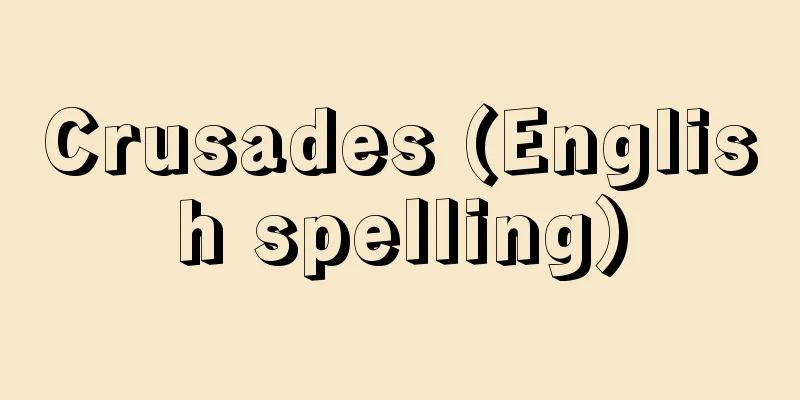Crusades (English spelling)

|
A general term for military expeditions that Western European Christians carried out in Eastern Europe and the Middle East on more than eight occasions between the end of the 11th century and the 13th century. In addition to official expeditions, crusades in a broad sense also include spontaneous actions by popular pilgrims and advances into neighboring regions that originated from crusader states in the Middle East. Crusades are also sometimes used to refer to the wars between Christian countries and the Ottoman Turkish Empire that began at the end of the 13th century and continued into the 16th century. This name has been used since the second half of the 13th century because participants wore a cross on their clothing, but earlier historical documents refer to them as "trips to Jerusalem" or "visits to the Holy Sepulchre." [Rinsuke Hashiguchi] originIn medieval Western European society, during the centuries leading up to the first half of the 11th century, a gradual improvement in natural conditions led to improvements in production and distribution, as well as an increase in population. This in turn promoted technological innovation and intellectual activity, and the lives of both emerging urban areas and traditional rural areas were revitalized side by side, resulting in a period of remarkable development in both material and spiritual terms. In the spiritual sphere, the spread of Christianity led to the flourishing of monastic culture, and the deepening of theology, philosophy, law, and literature gave rise to refined means of expressing faith, leading to the perfection of church art in the Romanesque style. Veneration of holy relics and visits to sanctuaries were typical of universal customs, and pilgrimages became a popular tradition that suited the mentality of believers as an act of atonement. Jerusalem, praised in the Psalm "Psalm of the Assumption" in the Old Testament, was considered the highest goal of pilgrimage as a holy city, and a visit to the Holy Sepulchre, the site of Christ's "suffering" described in the New Testament, was a lifelong wish for believers. On the other hand, in the middle of the 11th century, the balance between the three major political powers that made up the Mediterranean world - Western Europe, the Byzantine Empire, and the Islamic world - changed. Western Europe, which had been in a state of blockade up until then, shifted to a position of escaping the encirclement of Islamic forces, and the Byzantine Empire, unable to resist the oppression of Islam alone, requested aid from Western Europe. In response, the Christian peoples of Western Europe became passionate about their religious mission and saw this as an opportunity to satisfy their political, economic, and military ambitions, and sent armed pilgrims as an expeditionary force against Islam, with the justification of liberating the Holy Land. This momentum for overseas expansion, called the "Crusade Movement," spread throughout Western Europe, and all classes of feudal society were involved. The longing for the unknown Eastern world was combined with the desire to improve living standards and social status, and became the source of energy that caused the sustained and large-scale "de-Westernization" phenomenon. [Rinsuke Hashiguchi] MotivationThe launch of the Crusades was largely a response to the assessment of the domestic and international situations of the Byzantine Empire, a Christian country in Eastern Europe, and the movements of Islamic powers were only an indirect motive. In the mid-11th century, the Seljuk Turks gained control of the eastern Islamic world, occupying key locations in Syria and Asia Minor, including Jerusalem, and defeating the Byzantine army at Malazgirt (present-day eastern Turkey) in 1071. This caused a strong sense of crisis in the Byzantine Empire, which adopted a strategic pro-Western policy aimed at defending its territory and recovering lost territories. It requested mercenaries from Norman knights who had advanced into Naples and Sicily, and from Western European princes on pilgrimages to the Holy Land, and sought to re-establish ties with the Roman Papacy, with which it had been estranged since the separation of the Eastern and Western Churches in 1054, thus opening the way for Western intervention. Emperor Alexios I sent an envoy to the Council of Piacenza in the spring of 1095 to exaggerate the "Islamic disaster" in the East and complain about the damage suffered by Christians, churches, and pilgrims. In response, Pope Urban II conceived a plan to send a large-scale relief army with the goals of reuniting the Eastern and Western Churches, establishing a church state in the East, and mass immigration of Western European peoples. He proclaimed the launch of the First Crusade during the Council of Clermont in November of the same year. The gist of the crusade was to encourage all Christians to take a vow to visit the Holy Sepulchre as a duty, to recapture the holy cities under Islamic occupation, and to take military action to liberate the churches in Syria and Palestine. The Pope also wanted to resolve the "Investiture Controversy" with the German (Holy Roman) Emperor, a problem that had been pending since his accession to the throne, in his favor, and to achieve his desire to put an end to the private fighting between princes and knights, a chronic scourge in Western feudal society, through the "Peace of God" movement. In order to achieve this, he skillfully took advantage of the growing popularity of the Crusades and called on the French princes to organize an army with Adhémar, Bishop of Le Puy, as its commander-in-chief. [Rinsuke Hashiguchi] Structure and course of the CrusadesThe Crusades in a broad sense can be divided into four periods: the early, middle, late and "late Crusades", corresponding to the changing situations in Western Europe and the eastern Mediterranean world where they took place. [Rinsuke Hashiguchi] Early Crusades(Late 11th century to late 12th century) The First Crusade (1096-99), based on the Pope's exhortation at the Council of Clermont, consisted of four official expeditionary forces (Lorraine, Norman, Southern French, and Northern French troops), which captured Jerusalem in July 1099 and established the Kingdom of Jerusalem, including three feudal territories (County of Edessa, Principality of Antioch, and County of Tripoli) that they had acquired in Syria and Palestine. While consolidating its foundation, they also conducted offensive defensive operations against surrounding Islamic forces. During this period, an advance party of about 20,000 civilian pilgrims, led by the charismatic leader Peter the Hermit of Amiens, worked together with the official crusade. In 1101, approximately 200,000 people hoping to settle in the newly emerging Kingdom of Jerusalem set out east as the People's Crusade, escorted by a small number of knights, but were almost completely annihilated by attacks from the Seljuk army of the Rum Dynasty on the way. This shows that unarmed civilian groups formed the core of the crusade movement. The rule of the conquered territories was entrusted to the legion commander who had the distinction of being the first to occupy the walled city that was the center of the strategic target area, and the feudal system that had been established in Western Europe at that time was introduced, and a hierarchical pyramid of status was created, including kings, nobles, knights, citizens, and peasants, on top of a mosaic of fiefs of vassals. The throne of Jerusalem was inherited by hereditary succession, including female succession, since the first king, Godfrey of Basse-Lorraine, who held the title of "Protector of the Holy Sepulchre," and had the same authority as the monarchs of Western Europe. During the mid-12th century under Baldwin III (reigned 1144-62), the territory reached its greatest extent, stretching from the coast of the Euphrates River in the north to the Gulf of Aqaba in the Red Sea in the south. Considering the vast area, the population of the Western European rulers was extremely small, and most of the subjects were natives who escaped the massacres during the conquest or fled and then surrendered. The kingdom's military defense was entrusted to a small class of knights who were vassals to local lords, centering on the fortresses and knightly armies that belonged to the overseas provinces of the knightly orders that had been established one after another in Western Europe in the early 12th century. Meanwhile, the Islamic governments, which had happened to be divided by political conflict during the advance of the Crusades, finally began to feel motivated to unify their counterattack, and by the middle of the 12th century, the Islamic side had succeeded in recapturing the entire County of Edessa and the eastern half of the Principality of Antioch. Then, in the second half of the same century, Saladin's founding of the Ayyubid dynasty prompted the advocacy of a large-scale Islamic anti-Crusade known as a "Holy War." This resulted in the Second (1147-49) and Third (1189-92) Crusades, which ultimately failed and changed the nature of the early Crusades. In May 1146, at a meeting in Vézelay in central France, Bernard of Clairvaux, the leading spiritual leader in Western Europe at the time, gave a persuasive speech, and the Second Crusade was decided. In addition to the expeditionary forces under the command of King Louis VII of France and King Conrad III of Germany, the Templars, the Knights of St. John, and the army of the Kingdom of Jerusalem participated. They attacked Damascus, but were defeated by the fierce resistance of the besieged side, and instead of creating an effective situation for the defense of Antioch, they allowed the Zengids to expand their power. In addition, the intervention actions (several Egyptian expeditions) that the Kingdom of Jerusalem had carried out against the Fatimid Cairo Caliphate since 1163 triggered the Ayyubid dynasty's successful joint operation against Egypt and Syria, and the army of the Kingdom of Jerusalem suffered a disastrous defeat at the Battle of Hattin in July 1187. Then, in October of the same year, Saladin recaptured Jerusalem, and the fate of the Crusader nations became critical, which prompted the launch of the Third Crusade. The Crusaders, consisting of three great rulers, Frederick I (Redbeard) of the Holy Roman Empire, who was hegemonic throughout Western Europe at the time and threatening the authority of the Pope, Richard I (Lionheart) of England, who was popular as a model of chivalry, and Philip II (August), King of France, joined the Crusaders. They landed in Akko by a new route that partly used the Mediterranean sea route, and fought many battles with the aim of recapturing Jerusalem. However, due to the accidental death of Frederick I, the German army did not participate, and the discord between the British and French monarchs caused the crusade to end in failure, ushering in an era in which the enthusiasm for the Crusades in Western Europe began to wane. [Rinsuke Hashiguchi] The Middle Crusades(First half of the 13th century) In September 1192, a truce was concluded between Saladin and Richard I, who had fought alone until the end of the Third Crusade. The Kingdom of Jerusalem was reduced to the coastal area from Tyrus to Jaffa, and with its temporary capital in Acre, it moved into the Middle Crusade period, struggling to maintain its remaining territory on the defensive. On the other hand, the Ayyubid dynasty, which had recovered inland Syria and established a connection with Egypt, implemented a tolerant policy that allowed Christian pilgrims to pass through Jerusalem during the truce. Western Europe secured a means of communication between East and West by sea, using the newly acquired island of Cyprus as a stopover, and was able to manage its overseas colonies for another century, promoting both material and spiritual exchanges. The Fourth Crusade (1202-1204), also known as the "Crusade to Change Direction," was initiated by Pope Innocent III, who represented the height of Papacy, and persuaded by the hermit Foulques de Neuilly (years of birth and death unknown), who advocated the ideals of Western monasticism. However, the participating princes and knights lacked economic power and lacked unity in strategic thought, and they were drawn into the mercantile supremacy of the Venetians, leading to the extraordinary event of attacking the Christian Byzantine Empire, occupying Constantinople, and founding the "Latin Empire." This new empire, whose first emperor was the French Count Baldwin of Flanders (reigned around 1204-05), conquered Thrace, Macedonia, and various parts of Greece, temporarily integrating the Eastern Church under the Church of Rome and spreading Latin culture throughout Eastern Europe, but was counterattacked by the Byzantine emperor, who had fled to Asia Minor and was waiting for an opportunity to revive the empire, bringing its short-lived history to an end in 1261. The Fifth Crusade (1217-21) was also a kind of change-of-direction crusade, as it attacked Egypt instead of heading for Syria and Palestine. This crusade was an official crusade proclaimed by Pope Honorius III (reigned 1216-26), but participants were generally weak military forces such as the King of Hungary, the Duke of Austria, and Frisian knights, who were newly emerging Christian countries in Eastern Europe. The local army of the Kingdom of Jerusalem cooperated with them and could only occupy Damietta. Meanwhile, the Islamic Cairo government demanded the withdrawal of the crusaders in exchange for Damietta and Jerusalem. Cardinal Pelagius (date of birth and death unknown), the papal representative, made a bold proposal to reject these conditions, and the crusaders continued their attack on Cairo, but were hindered by Islamic counterattacks and floods of the Nile, losing all their gains and retreating. The Sixth Crusade (1228-29) by Holy Roman Emperor Frederick II, who was familiar with Islamic culture as King of Sicily, is sometimes not considered an official crusade because Frederick was excommunicated by Pope Gregory IX (reigned 1227-41) for delaying his departure. Frederick II had a personal friendship with the Sultan of Cairo, and through his marriage policy, he also became King of Jerusalem. He used diplomatic means to conclude the Jaffa Agreement in February 1229, and entered Jerusalem without bloodshed. The original purpose of the crusade was achieved through the idea of religious tolerance, but Western Europeans could not reach an agreement on political and economic interests, and conflicts between the excommunicated emperor and local princes and discord between peoples of different origins came to the surface, and the kingdom fell into chaos and anarchy. [Rinsuke Hashiguchi] The Last Crusades(Late 13th century) After the peaceful coexistence of Christianity and Islam came to an end with the sudden occupation of Jerusalem by the Khwarezmian Turks in 1244, the situation in the Near and Middle East entered a new phase of multipolarity, with various forces coming together and splitting apart. The Mongols advanced into Syria from behind the Khwarezmian Turks, and Western Europe, believing the Mongols to be Christians, envisaged an alliance. Within the Islamic world, Syria and Egypt were in conflict, while the unifying power of the new Mamluk dynasty rapidly grew. In Western Europe, Gothic art flourished under the political and economic dominance of the Kingdom of France, the devout faith of Louis IX (King Saint Louis) was seen as a model for Christians, and overseas missionary activities by mendicant monks were also active. There was also a strong enthusiasm for popular religious movements, such as the Children's Crusade and the Shepherds' Crusade, which had been repeated several times since the beginning of the 13th century, but the passion of the princes and knights who participated in military crusades was cooling. Louis IX's last two crusades (the seventh crusade, 1248-54, the eighth crusade, 1270) were based on the strategic idea that "the key to Jerusalem lies in Cairo," and he sent powerful armies to Egypt and Tunis, but both were defeated without having a direct impact on the rescue of the Holy Land, which was isolated under the Islamic siege, and instead ended up provoking the new Cairo government, the Mamluk dynasty, to sweep away Christians. From 1265 to 1291, the Kingdom of Jerusalem lost all of its remaining territories, including the Principality of Antioch and the County of Tripoli on the Syrian coast, and the direct territory of the Kingdom of Jerusalem was destroyed with the fall of its last stronghold, Acre. The few survivors barely managed to escape to the island of Cyprus, where they planned their future. [Rinsuke Hashiguchi] Later Crusades(14th to 16th centuries) For Christians, the loss of the Holy Land meant the end of the Crusades themselves, but the view of the East based on the political concept of war against Islam continued until the early modern period, and the conflict with the Mamluks and the new powerful enemy, the Ottoman Turkish Empire, are considered to be the "later Crusades." In this process, the Cyprus (Rhodes) Crusade in 1344 and the Nicopolis Crusade in 1396 are noteworthy. Both were defensive attacks by Eastern European Christian countries that were different from the rise of the Crusades in Western Europe, and in the 15th century, the Hungarian Crusade in 1440 marked a turning point, and the reversal of the relationship between the East and West powers became clear, with the Ottoman Empire's advance to the west reaching a peak, leading to the fall of the Byzantine Empire in 1453, and in the 16th century, the Ottomans were forced to completely abandon their naval control in the Eastern Mediterranean, and the Crusades disappeared in both name and reality. [Rinsuke Hashiguchi] Significance in world historyIn the 900 years since the Crusades began, their evaluations have been divided into pros and cons, and academic theories vary widely, but it is desirable to view them not simply as a record of a few military expeditions, but as a comprehensive overall picture of human society in the latter half of the Middle Ages in Western Europe, and to attempt to discover therein the identity of Western Europeans in their period of cultural prosperity. Furthermore, the influence of East-West exchange in the Mediterranean world that continued for several centuries was extremely significant, and there is no doubt that this long-term exchange broadened the spiritual and material horizons of civilization for over a dozen generations of coastal peoples, laying the groundwork for the development that eventually led to the global-scale "Age of Discovery." [Rinsuke Hashiguchi] "The Crusades: Demythologizing" by Hashiguchi Rinsuke (Iwanami Shinsho)" ▽ "The Crusades, by René Grusset, translated by Hashiguchi Rinsuke (Hakusuisha, Quessais-jes Bunko)" ▽ "The Crusades, by René Grusset, translated by Tachibana Saiji (Kadokawa Bunko)" ▽ "Studies on the Crusades, by Cecil Morrison, translated by Hashiguchi Rinsuke (Hakusuisha, Quessais-jes Bunko)" ▽ "Wars of the World 5: Wars of the Middle Ages and the Knights' Wars" edited by Kimura Shozaburo (1985, Kodansha)" ▽ "The Crusades, by Hashiguchi Rinsuke (Kyouikusha Rekishi Shinsho)" [Chronology] |©Shogakukan "> Crusader Route Source: Shogakukan Encyclopedia Nipponica About Encyclopedia Nipponica Information | Legend |
|
11世紀末から13世紀にかけて8回以上にわたって西欧キリスト教徒が東欧、中近東各地に向けて行った軍事遠征の総称。公式遠征のほかに民衆巡礼団の自発的行動や、中近東の十字軍国家を起点とする近隣地域への進出なども広義の十字軍に含まれる。また、13世紀末以降16世紀に及ぶキリスト教諸国とオスマン・トルコ帝国との戦争をも十字軍とよぶことがある。参加者が衣服に十字架の印をつけていたことから、13世紀後半以来この名称が用いられたが、それ以前の史料には「エルサレム旅行」または「聖墳墓詣(もう)で」などと記されている。 [橋口倫介] 起源中世西欧社会においては、11世紀前半までの数世紀間に、自然条件の緩慢な好転による生産・流通の向上と人口増加がみられ、これに伴って技術革新と知的活動が促進され、新興都市圏と伝統的農村地域の双方の生活が並んで活性化の方向をたどり、全般的に物心両面の著しい発展期を迎えていた。また精神面では、キリスト教の普及により修道院文化が栄え、神学、哲学、法学、文芸の深化は信心形態の洗練された表明手段を生み、ロマネスク様式による教会芸術の完成をみた。聖遺物崇敬や聖所参詣(さんけい)はその普遍的習俗の典型であり、巡礼は贖罪(しょくざい)行為として信徒の心性にかなう伝統となって流行した。『旧約聖書』の詩篇(しへん)「上京のうた」に賛美されたエルサレムは聖都として巡礼の最高目標と考えられ、『新約聖書』に記されたキリストの「受難」のゆかりの地である聖墳墓への参詣は信徒の生涯の悲願ともなっていた。 他方、11世紀中ごろに、地中海世界を構成する西欧、ビザンティン帝国、イスラム圏の三大政治勢力間にバランスの変化がおこり、それまで閉塞(へいそく)状態にあった西欧がイスラム勢力の包囲網をはねのける態勢に移行し、またビザンティン帝国がイスラムの圧迫に単独で対抗しえず、西欧に救援を要請するに至った。西欧キリスト教諸国民はこれを受けて宗教的使命感に情熱を燃やし、政治的、経済的、軍事的野心をも満たす好機とみて、聖地解放を大義名分とする武装巡礼団を対イスラム遠征軍として派遣することとなった。「十字軍運動」とよばれるこのような海外進出の気運は西欧全般にみなぎり、封建社会のすべての階層がこれにかかわり、未知の東方世界への憧憬(しょうけい)の念と、生活水準や社会身分の向上を望む欲求とが結び付き、持続的で大規模な「脱西欧」現象を引き起こすエネルギー源となった。 [橋口倫介] 動機十字軍遠征の発動は、多分に東欧のキリスト教国ビザンティン帝国の内外情勢判断に対応しており、イスラム勢力の動静は間接的な動機をなすにすぎない。11世紀中ごろセルジューク・トルコが東イスラム圏の実権を握り、エルサレムをはじめシリア、小アジアの要衝を相次いで占領し、1071年マラズギルトMalazgirt(現トルコ東部)でビザンティン軍を撃破したため、ビザンティン帝国は強い危機感を抱き、国土防衛と失地回復を目的とする戦略的親西欧政策を採用し、ナポリ、シチリアに進出していたノルマン人騎士や聖地巡礼途上の西欧諸侯に傭兵(ようへい)派遣を要請したり、1054年の東西教会分離以来疎遠になっていたローマ教皇庁との再接近を図るなど、西欧人の介入に道を開いた。皇帝アレクシオス1世は1095年春ピアチェンツァPiacenza教会会議に使節を送り、東方における「イスラム禍」を誇大に宣伝し、キリスト教信徒、教会、巡礼の被った被害を訴えた。これを受けて教皇ウルバヌス2世は、東西教会の再合同、東方における教会国家の創設、西欧諸国民の大量移民などを目的とする大規模な救援軍派遣計画を構想し、同年11月クレルモン公会議開催中に第1回十字軍発動の宣言を行った。その趣旨は、全キリスト教徒の義務として聖墳墓に参詣する誓願をたて、イスラム占領下の聖都を奪回し、シリア、パレスチナの教会を解放するための軍事行動を勧説するところにあった。同教皇はまた、即位以来の懸案であるドイツ(神聖ローマ)皇帝との「聖職叙任権闘争」を教皇側に有利に解決する意欲と、西欧封建社会の積弊であった諸侯・騎士同士の私的闘争を「神の平和」運動によって抑止する念願とを達成するため、十字軍運動の盛り上がりを巧みにとらえ、教皇代理ル・ピュイLe Puy司教アデマールAdhémarを総司令官とする軍団編成をフランス諸侯に呼びかけた。 [橋口倫介] 十字軍の構造と経過広義の十字軍は、その舞台となった西欧と東地中海世界の情勢変化に対応して、初期、中期、末期および「後の十字軍」の4段階に時代区分することができる。 [橋口倫介] 初期十字軍(11世紀末~12世紀末) クレルモン公会議における教皇の勧説を理論的根拠とする第1回十字軍(1096~99)の公式遠征隊4個軍団(ロレーヌ人、ノルマン人、南フランス人および北フランス人各部隊)は、1099年7月エルサレム占領を遂げ、シリア、パレスチナ一帯に獲得した3封建所領(エデッサ伯領、アンティオキア侯領、トリポリ伯領)を含むエルサレム王国を創設した。そして、その基礎を固めると同時に、周辺のイスラム勢力に対する攻勢的防衛作戦を行った。この時期には、アミアンの隠者ペトルスPetrusをカリスマ的指導者とする民間巡礼団約2万人の先発隊が公式十字軍と協働した。また1101年には、新興エルサレム王国への入植希望者約20万人が少数の騎士隊の護衛下に民衆十字軍として東方へ出発し、途中ルーム朝セルジューク軍の攻撃を受けてほとんど全滅の憂き目をみたが、これにより、非武装の民間人集団が十字軍運動の主体をなしていたことが看取される。 征服地の支配は、戦略目標地域の中心となる城壁都市の占領に一番乗りの功名を得た軍団司令官にゆだねられ、当時の西欧で確立されていた封建制を導入して、陪臣のモザイク的封土の上に、王、諸侯、騎士、市民、農民などの身分階層制のピラミッドが構成された。エルサレム王位は、初代の「聖墳墓守護職」という称号をとったバス・ロレーヌBasse-Lorraine侯ゴドフロア・ド・ブイヨン以来、女系相続を含む世襲制によって継承され、西欧諸国の君主と同等の権威を備えていた。12世紀中ごろのボードゥアン3世Baudouin Ⅲ(在位1144~62)時代に、その領土は、北はユーフラテス川沿岸から南は紅海のアカバ湾に至る最大版図に達した。この広大な面積に比して、西欧人支配者の人口はきわめて少数で、大部分の被支配者層は征服時の大虐殺を免れ、あるいは逃亡後帰順した原住民であった。王国の防衛軍事力は、12世紀初頭西欧に相次いで創設された騎士修道会の海外管区に属する城砦(じょうさい)と、騎士軍とを中心として、少数の現地諸侯に臣従する騎士階層にゆだねられていた。他方、十字軍の進出期にたまたま政治的対立から分裂していたイスラム諸政権側に、ようやく統一的反撃の気運が生まれ、12世紀中ごろまでに、イスラム側はエデッサ伯領全域とアンティオキア侯領の東半部との奪還に成功した。そして同世紀後半には、サラディンによるアイユーブ朝の創始を契機として大規模なイスラム側の反十字軍「聖戦」が唱道されたが、その結果、第2回(1147~49)、第3回(1189~92)十字軍が発動され、ついには挫折(ざせつ)をみることによって初期十字軍の性格は変質することとなる。 1146年5月フランス中部ベズレーVézelayの集会において、当時西欧随一の精神界の指導者であったクレルボーのベルナルドゥスにより勧説が行われ、第2回十字軍が決定した。フランス王ルイ7世、ドイツ王コンラート3世指揮下の遠征隊に加え、テンプル、聖ヨハネ両騎士修道会とエルサレム王国諸侯軍が参加した。ダマスカスを攻撃したが、籠城(ろうじょう)側の激しい抵抗に阻まれて敗退し、アンティオキア防衛に有効な状況を生むことなく、かえってザンギー朝の勢力拡大を許す結果となった。また、1163年以来エルサレム王国がカイロのファーティマ朝に対して行った干渉行動(数次のエジプト遠征)が引き金となって、アイユーブ朝のエジプト、シリア統合作戦が成功裏に進められ、1187年7月ハッティーンHattīn会戦においてエルサレム王国軍は惨敗を喫した。ついで同年10月サラディンによるエルサレム奪回が実現すると、十字軍国家の命運は危殆(きたい)に瀕(ひん)し、第3回十字軍の大々的発起を促すこととなった。当時西欧諸国中に覇を唱え、ローマ教皇の権威をも脅かす勢いにあった神聖ローマ帝国のフリードリヒ1世(赤髭(あかひげ)王)、騎士道精神の鑑(かがみ)として人気の高いイングランド王リチャード1世(獅子(しし)心王)およびフランス王フィリップ2世(尊厳王)の三大君主が勢ぞろいしたこの十字軍は、一部地中海航路を利用するようになった新ルートによってアッコAkkoに上陸し、エルサレム再占領を目ざして戦闘を繰り返した。しかし、フリードリヒ1世の事故死によるドイツ軍の不参と、英仏両国君主間の不和に災いされて結局竜頭蛇尾に終わり、西欧の十字軍熱にも陰りを生ずる時代を招いた。 [橋口倫介] 中期十字軍(13世紀前半) 1192年9月、第3回十字軍の最後まで孤軍奮闘したリチャード1世とサラディンとの間に休戦協定が成立し、エルサレム王国はティルスTyrusからヤッファJaffaまでの海岸部のみに領土を狭められた状況下に、アッコを臨時首府として残存領土の守勢的維持に汲々(きゅうきゅう)とする中期十字軍時代に移行する。他方、内陸シリアを回復しエジプトとの連係を確立したアイユーブ朝は、休戦期間中キリスト教徒巡礼のエルサレム通行権を許可する寛容政策を打ち出した。西欧側は、この時期に新たに領有したキプロス島を中継地として海路による東西連絡手段を確保しており、なお1世紀にわたってこの海外植民地を経営し、物心両面の交流を促進することができた。別名「方向転換十字軍」とよばれる第4回十字軍(1202~04)は、教皇権の絶頂期を代表するインノケンティウス3世の提唱により、また西欧修道制の理念を標榜(ひょうぼう)する隠修士フールク・ド・ヌイイFoulques de Neuilly(生没年不詳)の勧説によるものであったが、参加諸侯・騎士の経済力不足と戦略思想の不統一が災いして、ベネチア人の商業至上主義に引きずられ、キリスト教国であるビザンティン帝国を攻撃し、コンスタンティノープルを占領して「ラテン帝国」を創建するという異常な事件となった。フランス人のフランドル伯ボードゥアンBaudouin(在位1204~05ころ)を初代皇帝とするこの新帝国は、トラキア、マケドニア、ギリシア各地を征服し、東方教会を一時ローマ教会のもとに統合してラテン文化を東欧に広めたが、小アジアに亡命して復興の機をうかがっていたビザンティン皇帝によって反撃を受け、1261年その短命な歴史を閉じた。第5回十字軍(1217~21)も、シリア、パレスチナに向かわずエジプトを攻撃したということで、いわば方向転換十字軍であった。この十字軍は、教皇ホノリウス3世Honorius Ⅲ(在位1216~26)の宣布による公式十字軍であるが、参加者は東欧の新興キリスト教国ハンガリー王、オーストリア侯のほか、フリースラント人騎士など概して弱小な軍事力であり、これにエルサレム王国の現地軍が協働してダミエッタDamiettaを占領するのが精いっぱいであった。一方、イスラムのカイロ政権側では、ダミエッタとエルサレムの交換条件によって十字軍の撤退を求めた。教皇代理ペラギウスPelagius枢機卿(すうききょう)(生没年不詳)の強気の提案でこの条件を拒否し、カイロ攻撃を続行した十字軍は、イスラム側の反撃とナイル川洪水に妨げられ、すべての戦果を失って敗退した。 シチリア王としてイスラム文化に親しんだ神聖ローマ皇帝フリードリヒ2世による第6回十字軍(1228~29)は、出発遅延の理由で教皇グレゴリウス9世Gregorius Ⅸ(在位1227~41)からフリードリヒが破門されたため、公式十字軍とみなされない場合もある。フリードリヒ2世は、カイロのスルタンと個人的親交があり、結婚政策によってエルサレム王を兼ね、外交手段を用いて1229年2月ヤッファ協定を結び、エルサレムへの無血入城を果たした。宗教的寛容思想により十字軍の本来の目的が達成されたのであるが、政治的、経済的利害の側面では西欧人同士の調整がつかず、破門皇帝と現地諸侯の対立や出身地を異にする諸国民間の不和が表面化し、王国は無政府状態の混乱に陥っていく。 [橋口倫介] 末期十字軍(13世紀後半) キリスト教とイスラム教の平和共存が、1244年のホラズム・トルコ人によるエルサレム占領という突発事件によって終止符を打たれたのち、中近東情勢は多極的な諸勢力離合集散の新局面を迎える。ホラズム・トルコ人の背後からモンゴル人がシリアに進出し、西欧はモンゴル人をキリスト教徒と信じて同盟を構想し、イスラム圏内ではシリアとエジプトが対立する一方、新政権マムルーク朝による統一勢力が急速に成長してくる。西欧においては、フランス王国の政治的、経済的優位のもとにゴシック芸術が繁栄し、ルイ9世(聖ルイ王)の敬虔(けいけん)な信仰がキリスト教徒の模範とされ、托鉢(たくはつ)修道会士による海外布教活動も盛んであった。また13世紀初頭以来何度か繰り返された少年十字軍や牧童十字軍のように民衆宗教運動への熱意も強かったが、軍事力による十字軍遠征に参加する諸侯・騎士の情熱は冷却しつつあった。「エルサレムの鍵(かぎ)はカイロにあり」という戦略思想のもとにルイ9世が行った最後の2回の十字軍(第7回1248~54、第8回1270)は、エジプトとチュニスに向け精強な大軍を送ったが、いずれもイスラムの包囲網の中に孤立した聖地の救援に直接影響を与えることなく敗退し、かえってカイロの新政権マムルーク朝のキリスト教徒掃討作戦を挑発する結果を招いた。1265年から91年にかけて、シリア海岸のアンティオキア侯領、トリポリ伯領をはじめ残存領土のすべてを喪失、エルサレム王国直轄領は最後の拠点アッコの陥落によって滅亡した。わずかな生存者がかろうじてキプロス島に避難し、後図を図ることとなる。 [橋口倫介] 後の十字軍(14~16世紀) キリスト教徒にとって聖地の喪失は十字軍そのものの終焉(しゅうえん)を意味したが、対イスラム戦争という政略的構想による東方観は近世まで持続され、マムルーク朝との抗争、新しい強大な敵対者オスマン・トルコ帝国との対決は「後の十字軍」という観念で考えられている。その過程で、1344年のキプロス(ロードス)十字軍と1396年のニコポリス十字軍とが特筆される。いずれも西欧における十字軍運動の盛り上がりとは異なる東欧キリスト教諸国の守勢的攻撃であり、15世紀に入ると、1440年のハンガリー十字軍を転機として東西勢力関係の逆転が明らかとなり、オスマン帝国軍の西方進出が高潮期に達し、1453年にはビザンティン帝国の滅亡をみるに至り、16世紀には東地中海制海権の全面的放棄を強いられ、名実ともに十字軍は消滅する。 [橋口倫介] 世界史上の意義十字軍運動の開始以来今日まで約900年の間、その評価は賛否両論に分かれ、学説も区々であるが、これを単なる数回の軍事遠征の記録としてではなく、西欧中世後半期の人間社会の総合的全体像として観察し、そこに文化的高揚期の西欧人のアイデンティティをみいだそうと試みることが望ましい。また、数世紀にわたって持続された地中海世界の東西交流の影響はきわめて顕著であり、沿岸諸民族の十数世代の人々がこの長期の交流によって精神的、物質文明的視野を広げ、やがて地球的規模での「大航海時代」への発展を生む素地を築いたことも疑いない。 [橋口倫介] 『橋口倫介著『十字軍――その非神話化』(岩波新書)』▽『ルネ・グルッセ著、橋口倫介訳『十字軍』(白水社・文庫クセジュ)』▽『ルネ・グルッセ著、橘西路訳『十字軍』(角川文庫)』▽『セシル・モリソン著、橋口倫介訳『十字軍の研究』(白水社・文庫クセジュ)』▽『木村尚三郎編『世界の戦争5 中世と騎士の戦争』(1985・講談社)』▽『橋口倫介著『十字軍』(教育社歴史新書)』 [年表] |©Shogakukan"> 十字軍の経路 出典 小学館 日本大百科全書(ニッポニカ)日本大百科全書(ニッポニカ)について 情報 | 凡例 |
<<: Chu Si-gyŏng (Chu Shi Jing)
Recommend
Kawagato
…Most of the village area is mountainous, belongi...
Kuroda Nagamasa
Year of death: August 4, 1623 (August 29, 1623) Ye...
Ota Tenjinyama Ancient Tomb - Ota Tenjinyama Ancient Tomb
Located in Ota City, Gunma Prefecture, this is a k...
Khālid b. 'Abd al-'Azīz
…Relations with the United States also became ten...
Opening - Kaigo
〘noun〙[一] Opening and closing. ① To open and join ...
Septic arthritis
… [Infectious arthritis] Arthritis is most often ...
Kurt Dynasty - Kurt
A native government in Afghanistan under Mongol ru...
"Songs by the Stream" - Ogawa no hotori no gakkyoku
…Stravinsky used a chamber orchestra of seven mus...
Hydatidiform Mole
◎ Abnormal proliferation of the villi that make up...
Reinforced Wood - Kyokaboku
〘 noun 〙 Reinforced plywood is made by impregnatin...
Acute anterior poliomyelitis (poliomyelitis)
What is the disease? Spinal cord ( Spinal cord ) ...
Christchurch - Christchurch (English spelling)
It is a city located on the east coast of the Cant...
Lord Overstone - Lord Overstone
… As a preventive measure, proponents of the law,...
Magnetism
…Magnets attract so-called ferromagnetic material...
Artemision
…In the Peloponnesian War, the Greeks sided with ...









